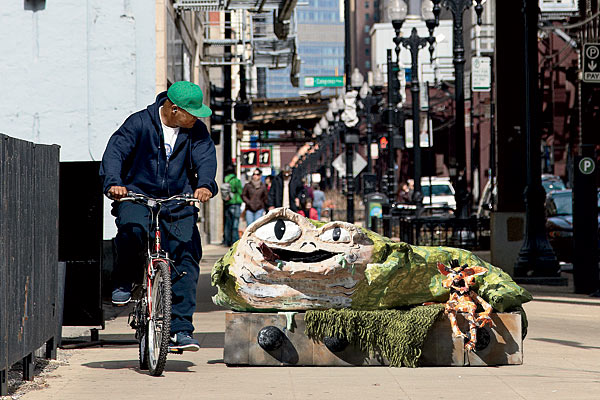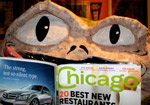
Parka the Hutt on his day out in Chicago. For more behind-the-scenes photos, including the making of the monster, launch the gallery »
Related:

PHOTOS: Behind the scenes with Parka the Hutt »
MORE BY JEFF RUBY
Inside the Mind of an Art Institute Guard »
Chicago Restaurant Critics Talk Food Fights »
Finding the Perfect Bike in Chicago »
Barack Obama, Next-Door Neighbor »
Are Police Sketch Artists Becoming Obsolete? »
Facing His 40th Birthday, A Chicago Man Runs 40 Races »
Meet the Doughnut-Craziest Family in Chicago »
A Desperate Man Road-Tests Trunk Club »
Following a Freak Accident, a Father Faces a Grueling Choice »
One Hoarder’s Last Hope: Asking a Stranger to Move In »
Beer Tips From Steve Hamburg, Chicago’s Cask King »
Mutt Versus Jeff: One Animal-Ignorer’s Experience with the Wild New Family Dog »
Anonymous Restaurant Reviewing: Journalistic Gold Standard or Antiquated Parlor Game? »
Lousy Parenting: One Family’s Experience with Head Lice Removal »
Suddenly they’re everywhere. Nestled in gutters, clogging up dashboards, swirling around alleys and avenues like ticker tape after a parade. I unknowingly spent an entire day with one stuck to the bottom of my shoe. Nobody’s sure what to call them. Parking stubs? Pay box receipts? Beelzebub’s confetti? Three years ago, they didn’t exist, but today they have become as much a part of Chicago’s fabric as kielbasa and bribery.
You know the story. In 2009, Chicago Parking Meters, a consortium of investors headed by Morgan Stanley, won the $1.16 billion city contract to replace 36,000 parking meters with 4,600 pay boxes. This decision infuriated residents on multiple grounds: financial (rate hikes!), political (privatization!), cultural (“I ain’t walkin’ half a block to wait in line and freeze my butt off!”), and even aesthetic (“The boxes look like Martian toilets!”). Mayor Daley got crucified for rushing the deal through City Council; others directed their rage at LAZ Parking, the humorless outfit that maintains the pay boxes. The money from the deal is nearly gone.
But my issue is all these damn stickers. Each stub—hugely valuable during its two-hour lifespan, garbage afterward—seems to beget exponentially more. Put a couple together and they apparently reproduce, then their offspring promptly do the same, spawning a whole promiscuous sticker family. “They’re like an urban version of cottonwood trees that cover the sidewalks and clog sewers,” says Mike Brockway, the Chicago blogger who runs TheExpiredMeter.com. (Brockway favors using cell phones to pay for parking. The technology exists.) The city swears the stickers are biodegradable, but my gut tells me that in the event of a nuclear war, cockroaches are going to be asking them for advice.
At some point, I began collecting stickers in hopes of turning trash into a stunning work of art that would reflect Chicago’s bureaucratic follies. I plucked them from the streets, begged friends and colleagues, posted pleas on Facebook and Twitter, and got Nick Digilio of WGN Radio to ask listeners for help. The day I saw dozens of stickers littering the back seat of a Corolla on North Clark and checked if the door was locked, my quest officially ended.
Then I remembered that I am not an artist. So I gave the whole stack to Jon Belonio, a 37-year-old elementary school art teacher in the western suburbs and an old friend of my wife’s. Belonio is the kind of guy who doodles obsessively and runs half marathons done up as a zombie Captain America. His Romeoville basement is a pop culture wonderland overflowing with comic books, video games, lunchboxes, paintings, pennants, and pinball machines. Basically, the guy has the art knowledge of a master and the unhinged creativity of a teenage boy: the right combination for this project.
“I’m thinking of a parking sticker monster that looks like Jabba the Hutt,” said Belonio, whose thoughts drift to Star Wars roughly every two minutes. “We are Han Solo, and Jabba represents the crazy parking policies we have to deal with.” Chicago’s bloated bureaucracy as a giant, gluttonous alien called a “slimy piece of worm-ridden filth” in Return of the Jedi? Yes, please. Belonio started immediately.
Twelve days later, with help from his two young sons and his wife—who did touchups while he was at work—Belonio finished Parka the Hutt, a six-foot-long slug held together by chicken wire, crumpled newspaper, tape, glue, acrylic paint, modeling clay, nail polish, and hundreds of pay box stickers. He added Salacious B. Crumb, Jabba’s sadistic sidekick, constructing his skin from orange parking violation notices. “This may be my defining moment as an artist,” Belonio told his wife one night while they ate dinner; Parka stuck his tongue out at them from the dining room counter.
We weren’t sure what to with the sculpture. The Art Institute did not want it, and George Lucas’s people never got back to me. I thought it might be cool to display Parka on the steps outside of City Hall as some kind of protest, until someone reminded me that City Hall doesn’t have steps. A coworker proposed putting it on the lawn of the man who negotiated the pay box deal, William Strong, the vice chairman of investment something or other at Morgan Stanley. But it turns out Strong sold his $5.2 million Lake Forest mansion in 2011 and split for Hong Kong, where he is reportedly still circling the block looking for parking.
In the end, Parka came out for a six-hour photo shoot to accompany this article, stopping at locales such as Harold’s Chicken Shack on South Wabash and the skate park at Wilson Beach. “It looks like the Blarney Stone,” remarked one woman, who threatened to kiss it. A fisherman on the lakefront near Adler Planetarium felt compelled to put a perch in Parka’s mouth. Everywhere the hoss went, Chicagoans swarmed, welcoming the opportunity to vent about our predetermined parking fate.
After the last camera bulb had flashed, the beast slithered back to exile in Romeoville. He may spend some time in Belonio’s classroom, where he’ll teach students that sculptures can be made of anything. But most likely, Parka will end up in Belonio’s basement, stuck between, say, the Incredible Hulk clock and ginormous Michael Jordan Wheaties box. Which seems to fit. When your great-grandchild is grumbling about putting a parking receipt on his dashboard in 2084, another forgotten symbol of this city’s backroom dealings—and our impotence in stopping them—will be gathering dust under a house in the suburbs.
To see pics of Parka the Hutt coming to life in the hands of artist Jon Belonio (and his sons)—plus shots of the monster on the day of its photo shoot—launch the gallery.
Photograph: Christopher Semel


